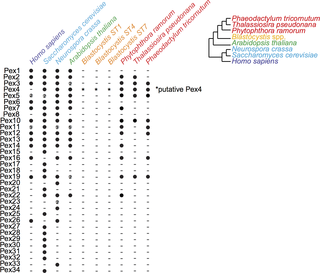PLOS Biology ( IF 9.8 ) Pub Date : 2017-09-11 , DOI: 10.1371/journal.pbio.2003769 Eleni Gentekaki 1, 2 , Bruce A Curtis 1, 2 , Courtney W Stairs 1, 2 , Vladimír Klimeš 3 , Marek Eliáš 3 , Dayana E Salas-Leiva 1, 2 , Emily K Herman 4 , Laura Eme 1, 2 , Maria C Arias 5 , Bernard Henrissat 6, 7, 8 , Frédérique Hilliou 9 , Mary J Klute 4 , Hiroshi Suga 10 , Shehre-Banoo Malik 1, 2 , Arthur W Pightling 1 , Martin Kolisko 1, 2 , Richard A Rachubinski 4 , Alexander Schlacht 4 , Darren M Soanes 11 , Anastasios D Tsaousis 1, 2 , John M Archibald 1, 2, 12 , Steven G Ball 5 , Joel B Dacks 4 , C Graham Clark 13 , Mark van der Giezen 14 , Andrew J Roger 1, 2, 12

|
Blastocystis is the most prevalent eukaryotic microbe colonizing the human gut, infecting approximately 1 billion individuals worldwide. Although Blastocystis has been linked to intestinal disorders, its pathogenicity remains controversial because most carriers are asymptomatic. Here, the genome sequence of Blastocystis subtype (ST) 1 is presented and compared to previously published sequences for ST4 and ST7. Despite a conserved core of genes, there is unexpected diversity between these STs in terms of their genome sizes, guanine-cytosine (GC) content, intron numbers, and gene content. ST1 has 6,544 protein-coding genes, which is several hundred more than reported for ST4 and ST7. The percentage of proteins unique to each ST ranges from 6.2% to 20.5%, greatly exceeding the differences observed within parasite genera. Orthologous proteins also display extreme divergence in amino acid sequence identity between STs (i.e., 59%–61% median identity), on par with observations of the most distantly related species pairs of parasite genera. The STs also display substantial variation in gene family distributions and sizes, especially for protein kinase and protease gene families, which could reflect differences in virulence. It remains to be seen to what extent these inter-ST differences persist at the intra-ST level. A full 26% of genes in ST1 have stop codons that are created on the mRNA level by a novel polyadenylation mechanism found only in Blastocystis. Reconstructions of pathways and organellar systems revealed that ST1 has a relatively complete membrane-trafficking system and a near-complete meiotic toolkit, possibly indicating a sexual cycle. Unlike some intestinal protistan parasites, Blastocystis ST1 has near-complete de novo pyrimidine, purine, and thiamine biosynthesis pathways and is unique amongst studied stramenopiles in being able to metabolize α-glucans rather than β-glucans. It lacks all genes encoding heme-containing cytochrome P450 proteins. Predictions of the mitochondrion-related organelle (MRO) proteome reveal an expanded repertoire of functions, including lipid, cofactor, and vitamin biosynthesis, as well as proteins that may be involved in regulating mitochondrial morphology and MRO/endoplasmic reticulum (ER) interactions. In sharp contrast, genes for peroxisome-associated functions are absent, suggesting Blastocystis STs lack this organelle. Overall, this study provides an important window into the biology of Blastocystis, showcasing significant differences between STs that can guide future experimental investigations into differences in their virulence and clarifying the roles of these organisms in gut health and disease.
中文翻译:

超流行的寄生真核生物芽囊菌的极端基因组多样性
芽囊菌是人类肠道中最常见的真核微生物,感染全球约 10 亿人。尽管芽囊菌与肠道疾病有关,但其致病性仍然存在争议,因为大多数携带者没有症状。这里展示了芽囊菌亚型 (ST) 1 的基因组序列,并与之前发布的 ST4 和 ST7 序列进行了比较。尽管基因核心保守,但这些 ST 在基因组大小、鸟嘌呤胞嘧啶 (GC) 含量、内含子数量和基因含量方面存在意想不到的多样性。ST1 有 6,544 个蛋白质编码基因,比报道的 ST4 和 ST7 多数百个。每个 ST 特有的蛋白质百分比范围为 6.2% 至 20.5%,大大超过了在寄生虫属内观察到的差异。直系同源蛋白在 ST 之间的氨基酸序列同一性上也表现出极大的差异(即 59%–61% 中值同一性),这与对寄生虫属最远亲缘物种对的观察结果相当。ST 还显示出基因家族分布和大小的显着差异,尤其是蛋白激酶和蛋白酶基因家族,这可能反映了毒力的差异。这些 ST 间差异在 ST 内水平上持续到什么程度还有待观察。ST1 中 26% 的基因具有终止密码子,这些终止密码子是通过仅在芽囊藻中发现的新型多腺苷酸化机制在 mRNA 水平上产生的。通路和细胞器系统的重建表明,ST1具有相对完整的膜运输系统和近乎完整的减数分裂工具包,可能表明有性周期。与一些肠道原生寄生虫不同,芽囊藻ST1 具有近乎完整的从头开始的嘧啶、嘌呤和硫胺素生物合成途径,并且在所研究的原生藻菌中独一无二,能够代谢 α-葡聚糖而不是 β-葡聚糖。它缺乏编码含血红素的细胞色素 P450 蛋白的所有基因。线粒体相关细胞器 (MRO) 蛋白质组的预测揭示了扩展的功能库,包括脂质、辅因子和维生素生物合成,以及可能参与调节线粒体形态和 MRO/内质网 (ER) 相互作用的蛋白质。与此形成鲜明对比的是,过氧化物酶体相关功能的基因不存在,表明芽囊菌ST 缺乏这种细胞器。总体而言,这项研究为了解芽囊藻的生物学提供了一个重要的窗口,展示了 ST 之间的显着差异,可以指导未来对其毒力差异的实验研究,并阐明这些生物体在肠道健康和疾病中的作用。



























 京公网安备 11010802027423号
京公网安备 11010802027423号